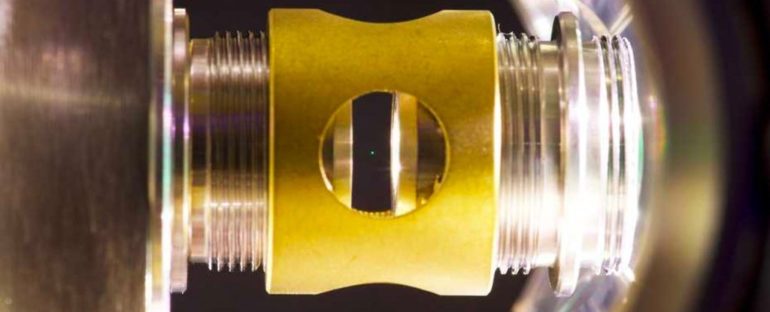Quantum mechanics deals with the behavior of the Universe at the super-small scale: atoms and subatomic particles that operate in ways that classical physics can’t explain. In order to explore this tension between the quantum and the classical, scientists are attempting to get larger and larger objects to behave in a quantum-like way.
In the case of this particular study, the object in question is a tiny glass nanosphere, 100 nanometers in diameter – about a thousand times smaller than the thickness of a human hair. To our minds that’s very, very small, but in terms of quantum physics, it’s actually rather huge, made up to 10 million atoms.
Pushing such a nanosphere into the realm of quantum mechanics is actually a huge achievement, and yet that’s exactly what physicists have now accomplished.
Using carefully calibrated laser lights, the nanosphere was suspended in its lowest quantum mechanical state, one of extremely limited motion where quantum behavior can start to happen.
“This is the first time that such a method has been used to control the quantum state of a macroscopic object in free space,” says Lukas Novotny, a professor of photonics from ETH Zurich in Switzerland.
To achieve quantum states, movement and energy must be dialed right down. Novotny and his colleagues used a vacuum container cooled down to -269 degrees Celsius (-452 degrees Fahrenheit) before using a feedback system to make further adjustments.
Using the interference patterns generated by two laser beams, the researchers calculated the exact position of the nanosphere inside its chamber – and from there the precise adjustments required to bring the movement of the object close to zero, using the electrical field created by two electrodes.
It’s not all that different from slowing down a playground swing by pushing and pulling it until it comes to a resting point. Once that lowest quantum mechanical state has been reached, further experiments can begin.
“To clearly see quantum effects the nanosphere needs to be slowed down… all the way to its motional ground state,” says electrical engineer Felix Tebbenjohanns, from ETH Zurich.
“This means that we freeze the motional energy of the sphere to a minimum that is close to the quantum mechanical zero-point motion.”
While similar results have been achieved before, they used what’s known as an optical resonator to balance objects using light.
The approach used here better protects the nanosphere against disturbances, and means the object can be viewed in isolation after the laser is turned off – although that will require plenty of further research to realize.
One of the ways the researchers hope their findings can be useful is in studying how quantum mechanics causes elementary particles to behave like waves. It’s possible that super-sensitive setups like this nanosphere one could also help in the development of next-generation sensors beyond anything we have today.
Managing to levitate such a large sphere in a cryogenic environment represents a significant jump towards the macroscopic scale where the line between the classical and the quantum can be studied.
“Together with the fact that the optical trapping potential is highly controllable, our experimental platform offers a route to investigating quantum mechanics at macroscopic scales,” conclude the researchers in their published paper.
The research has been published in Nature.



